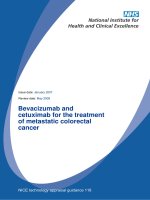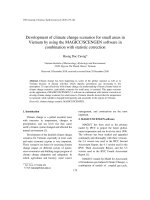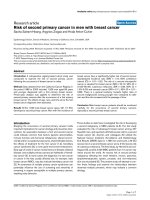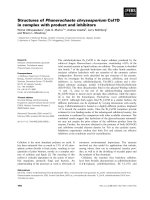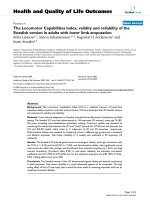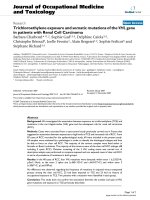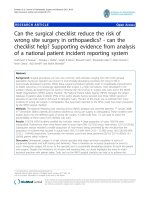Risk of second primary cancer in men with breast cancer docx
Bạn đang xem bản rút gọn của tài liệu. Xem và tải ngay bản đầy đủ của tài liệu tại đây (120.7 KB, 7 trang )
Open Access
Available online />Page 1 of 7
(page number not for citation purposes)
Vol 9 No 1
Research article
Risk of second primary cancer in men with breast cancer
Sacha Satram-Hoang, Argyrios Ziogas and Hoda Anton-Culver
Epidemiology Division, School of Medicine, University of California, Irvine, CA 92697, USA
Corresponding author: Hoda Anton-Culver,
Received: 22 Sep 2006 Revisions requested: 13 Nov 2006 Revisions received: 21 Nov 2006 Accepted: 25 Jan 2007 Published: 25 Jan 2007
Breast Cancer Research 2007, 9:R10 (doi:10.1186/bcr1643)
This article is online at: />© 2007 Satram-Hoang et al.; licensee BioMed Central Ltd.
This is an open access article distributed under the terms of the Creative Commons Attribution License ( />),
which permits unrestricted use, distribution, and reproduction in any medium, provided the original work is properly cited.
Abstract
Introduction A retrospective registry-based cohort study was
conducted to examine the risk of second primary cancer
following the occurrence of breast cancer in males.
Methods Data obtained from the California Cancer Registry in
the period 1988 to 2003 included 1,926 men aged 85 years
and younger diagnosed with a first primary breast cancer.
Person-year analysis was applied to determine the risk of
second primary cancers after the occurrence of a first primary
breast cancer. The effects of age, race, and time since the first
breast cancer diagnosis were assessed.
Results Of the 1,926 male breast cancer cases, 221 (11.5%)
developed a second primary cancer. Men with first incidence of
breast cancer have a significantly higher risk of second cancer
(standardized incidence ratio (SIR) = 1.16, 95% confidence
interval (CI) = 1.01–1.32). The risk of a second site-specific
cancer is elevated for breast cancer (SIR = 52.12, 95% CI =
31.83–80.49), cutaneous melanoma (SIR = 2.98, 95% CI =
1.63–5.00) and stomach cancer (SIR = 2.11, 95% CI = 1.01–
3.88). There is a general tendency towards higher risks of
second malignancies among younger men compared to older
men and the risk increased with the passage of time.
Conclusion Male breast cancer patients should be monitored
carefully for the occurrence of second primary cancers,
especially a second primary breast cancer.
Introduction
Studying the occurrence of second primary cancers holds
important implications for cancer etiology and preventive inter-
ventions. An association between a first and second cancer
could indicate common host factors (genetic abnormalities,
immune function and hormonal imbalances), shared environ-
mental and/or occupational exposures, shared lifestyle factors,
the effects of treatment for the first cancer [1,2], hereditary
cancer syndromes [3], or even gene-environment interactions.
Early age of onset of cancer, family history of disease, bilateral
disease, and multiple primary cancers are hallmarks of heredi-
tary cancer [3]. In some cases, the diagnosis of a rare cancer
or cancer in the less usually affected sex, for example, male
breast cancer (MBC), may also indicate hereditary cancer risk
[3]. An awareness of multiple primary cancer syndromes can
potentially influence the use of screening and sensitivity of
screening in organs susceptible to multiple primary cancers,
enabling early detection.
Three studies to date have investigated the risk of developing
a second malignancy in MBC patients [4-6]. The first study
evaluated the risk of subsequent breast cancer among 457
Swedish men, and reported a 93-fold excess risk for a second
breast cancer [4]. Auvinen and colleagues [5] utilized the
National Cancer Institute's Surveillance and Epidemiology
End Results (SEER) data for 1,788 men and found a 30-fold
excess risk of a second breast cancer and a 2-fold excess risk
of cutaneous melanoma. The third study, by Hemminki and col-
leagues [6], pooled 3,409 MBC patients from 13 cancer reg-
istries around the world. An excess risk of second primary
malignancy affecting the small intestine, rectum, pancreas,
lymphohematopoietic system, prostate, and non-melanoma
skin was elucidated [6]. The present study will attempt to con-
firm these findings and examine the relationships between
observed multiple primaries, which may indicate a common
etiology.
CCR = California Cancer Registry; CI = confidence interval; MBC = male breast cancer; SIR = standardized incidence ratio.
Breast Cancer Research Vol 9 No 1 Satram-Hoang et al.
Page 2 of 7
(page number not for citation purposes)
Materials and methods
A registry-based cohort of men previously diagnosed with first
primary breast cancer was followed through time to compare
their subsequent cancer experience to the number of cancers
that would be expected based on incidence rates for the gen-
eral California male population. The data were obtained from
the California Cancer Registry (CCR), California's statewide
population-based cancer surveillance system. The CCR is a
collaborative effort involving the California Department of
Health Services, ten regional registries, hospitals, cancer
researchers throughout the nation, and the Public Health Insti-
tute. It collects information about all cancers diagnosed in Cal-
ifornia (except basal and squamous cell carcinoma of the skin
and carcinoma in situ of the cervix). The database includes
information on demographics, tumor characteristics (stage,
grade, histology, laterality, behavior, and hormone receptor
status), treatment, survival, and reporting hospital type.
The present study includes 1,926 males aged 85 years or less
diagnosed with first primary breast cancer between 1 January
1988 and 31 October 2003, registered at the CCR. A second
primary cancer was defined in this study as a malignant meta-
chronous tumor that developed at least two months after first
primary male breast cancer diagnosis. There were 221
(11.5%) second primaries diagnosed in this cohort of men
during the study period. Synchronous tumors occurring less
than two months from first primary breast cancer were
excluded in order to control for detection bias due to diagnos-
tic methodology and also to be consistent with prior research
conducted in the same geographic region [5]. Ninety-three
percent of the cohort received surgery. In addition, 25%
underwent adjuvant hormone therapy, 24% chemotherapy,
and 20%, radiation therapy, while 19% of the cohort had some
combination therapy. No men were excluded from the analysis
due to missing data as information regarding second malig-
nancy, date of diagnosis and date of last contact or death were
available for all patients.
For the purposes of rate adjustment, five-year age groups,
resulting in 18 age categories, were used in calculating the
expected number of cases. Race/ethnicity was categorized
into five mutually exclusive groups: non-Hispanic white, Black,
Hispanic, Asian/Pacific Islander, and other/unknown. To cal-
culate the expected number of cancers for the other/unknown
group, we used the incidence rates of all others combined.
The calendar period was classified in five-year categories of
diagnosis: 1988 to 1992, 1993 to 1997, and 1998 to 2003.
Tumor site codes in accordance with SEER definitions for
breast, prostate, colorectal, lung and bronchus, bladder,
melanoma, and stomach cancer were obtained from the CCR
[7]. The unit of analysis in our study was person/days at risk in
order to maximize use of fractions of years if applicable. Per-
son-years of observation were calculated two months from the
date of breast cancer diagnosis up to and including age 85,
the date of the second primary cancer, date of last contact or
death, or study end (31 December 2003), whichever came
first.
Statistical analysis
All statistical analysis conducted utilized SAS v 9.1 software.
(SAS Institute Inc., SAS Campus Drive, Cary, North Carolina
27513, USA) Using the frequency procedure in SAS, the dis-
tribution of risk factors of interest among cohort members
(Table 1) was evaluated. Chi-square analysis for categorical
data and t-test for continuous data were used to compare the
characteristics between patients who subsequently devel-
oped a second primary to those who did not (Table 1). Differ-
ences with a probability of p < 0.05 were considered
statistically significant.
Person-years analysis, adjusted for age, race, calendar period,
and tumor site, was used to calculate the standardized inci-
dence ratio (SIR) (Tables 2 to 5). The SIR is a comparison of
the incidence of second primary tumors among study patients
(observed) with the incidence of the same tumors in the gen-
eral population of California males (expected). Calculation of
the expected numbers of second primaries was accomplished
by applying sex, five-year age, race, calendar period and site-
specific incidence rates from the general population of Califor-
nia males to the person-years at risk in the study population.
To assess statistical significance, exact 95% confidence inter-
vals (CI) were computed around the SIR assuming that the
observed number of second cancers followed a Poisson
distribution.
Results
The characteristics of men diagnosed with first primary breast
cancer are shown in Table 1. The cohort contained a total of
1,926 men of which 221 (11.47%) subsequently developed a
second metachronous malignancy. Approximately 68% of the
cohort were 60 years of age or older. Patients who developed
a second cancer were older (mean age = 66.90) compared to
patients who did not experience a subsequent cancer
diagnosis (mean age = 64.16) (p = 0.0002). The mean and
median follow-up times for this cohort were 4.39 and 3.36
years, respectively, with no overall significant difference in fol-
low-up time between the two groups. The majority of cases
were non-Hispanic white (76%) with all other races (blacks,
Hispanics, Asians and other/unknown) making up the remain-
der of the population.
The overall SIRs for second malignancy by tumor site, control-
ling for age, race and calendar period, are shown in Table 2 for
sites where at least ten cases were recorded. The observed
number of second primary malignancies was 221 compared to
190.42 expected, thereby producing an SIR of 1.16 (95% CI
= 1.01–1.32), which shows an excess risk of 16%. The
excess risk of subsequent cancer decreased to 5% when sec-
ond breast cancer was excluded and the result is not statisti-
cally significant. Overall, a significant excess of second
Available online />Page 3 of 7
(page number not for citation purposes)
primary was noted for breast cancer (SIR = 52.12, 95% CI =
31.83–80.49), cutaneous melanoma (SIR = 2.98, 95% CI =
1.63–5.00), and stomach cancer (SIR = 2.11, 95% CI =
1.01–3.88).
The effect of diagnostic age on risk of subsequent cancer is
presented in Table 3. The SIR or risk ratio for all malignancies
combined (breast included and breast excluded) was highest
in the younger population. A similar pattern was also observed
for second breast cancer with higher excess risks starting in
the <60 years age group and decreasing with increasing age.
A significant excess of skin melanoma (SIR = 3.18, 95% CI =
1.17–6.93) was noted among men 70 years or older. In
patients diagnosed between 60 and 69 years, a 2-fold
increased risk of colorectal cancer was observed. Patients 70
years or older experienced a lower risk of lung and bronchus
cancer (SIR = 0.47, 95% CI = 0.19–0.97).
The effect of race on subsequent cancer risk, controlling for
age and calendar period, is shown in Table 4. The 39
observed second primaries in the 'other' race/ethnic category
comprise 15 black, 17 Hispanic and 7 Asian/Pacific Island
men. Overall, non-Hispanic whites (SIR = 1.19, 95% CI =
1.02–1.38) showed a significant excess of subsequent can-
cers. When breast was excluded, the excess of second prima-
ries was no longer observed. Second breast cancer is
elevated in both racial/ethnic categories. However, the excess
risk was more prominent in the 'other' ethnic background com-
pared to non-Hispanic whites. The increased risk of second
primary breast cancer among the 'other' racial/ethnic category
is largely due to the risk among blacks. The risk of melanoma
among non-Hispanic white men was three-fold that expected.
A significant excess in stomach cancer was observed in non-
Hispanic white males (SIR = 2.53, 95% CI = 1.09–4.99).
The SIRs for second malignancy by length of time after breast
cancer diagnosis, controlling for age, race and calendar
period, is shown in Table 5. The risk of all malignancies com-
bined was significantly lower than expected in the first year of
follow-up (SIR = 0.74, 95% CI = 0.53–0.99) and higher than
expected after 5 years of follow-up (SIR = 1.63, 95% CI =
1.31–2.00). When breast cancer was excluded, the risk was
21% lower than expected in the first 5 years after diagnosis,
but later increased to 45% after 5 years of follow-up. Second
breast cancer was higher in each follow-up category, with the
highest risk after five years of follow-up. A higher SIR was
observed after 5 years from diagnosis for bladder cancer (SIR
= 2.89, 95% CI = 1.49–5.05). Melanoma was in excess for 2
follow-up periods: 1 to 5 years (SIR = 2.68, 95% CI = 1.08–
5.53) and >5 years (SIR = 4.15, 95% CI = 1.52–9.02). Lung
Table 1
Characteristics of male breast cancer patients
Characteristic No second cancer Second cancer Total P value
Age (mean years (SD)) 64.16 (12.90) 66.90 (9.72) 64.47 (12.61) 0.0002
Follow-up (mean years (SD)) 4.39 (3.74) 4.38 (3.31) 4.39 (3.69) 0.9405
Age (median years (IQR) 66.00 (55.00–74.00) 68.00 (61.00–73.00) 66.00 (56.00–74.00)
Follow-up (median years (IQR) 3.35 (1.33–6.69) 3.39 (1.46–6.82) 3.36 (1.33–6.72)
Age (no. of subjects (percent))
<60 years 577 (33.84) 41 (18.55) 618 (32.09) <0.0001
60 to 69 years 458 (26.86) 89 (40.27) 547 (28.04)
70+ years 670 (39.30) 91 (41.18) 761 (39.51)
Follow-up (no. of subjects (percent))
<1 year 342 (20.06) 42 (19.00) 384 (19.94) 0.4921
1 to 5 years 731 (42.87) 88 (39.82) 819 (42.52)
>5 years 632 (37.07) 91 (41.18) 723 (37.54)
Race (no. of subjects (percent))
Non-Hispanic white 1,272 (74.60) 182 (82.35) 1,454 (75.49) 0.0117
Other 433 (25.40) 39 (17.65) 472 (24.51)
Total (no. of subjects (percent)) 1,705 (88.53) 221 (11.47) 1,926 (100.00)
A p value < 0.05 means statistically significant. IQR, interquartile range; SD, standard deviation.
Breast Cancer Research Vol 9 No 1 Satram-Hoang et al.
Page 4 of 7
(page number not for citation purposes)
and bronchus cancer was protective in the first five years after
diagnosis. We also analyzed the data stratified by treatment
type and subsequent cancer risk. We did not find any statisti-
cal associations with the risk of second cancers.
After more than five years had elapsed, significant excess risks
were associated with men in the younger age categories
(Table 5). The risk was 3-fold in men under 60 and 2-fold in
men 60 to 69 years of age at diagnosis. A 62% lower risk was
noted in men 60 to 69 years of age within the first year of fol-
low-up time.
Table 2
Risk of second primary cancer among men with first primary breast cancer
Cancer site N PERYR OBS EXP SIR (95 percent CI)
All malignancies, breast included 1,926 8,460.08 221 190.42 1.16 (1.01–1.32)
All malignancies, breast excluded 1,926 8,529.63 201 191.63 1.05 (0.91–1.20)
Prostate 1,926 8,803.74 69 72.30 0.95(0.74–1.21)
Second breast 1,906 8,947.89 20 0.38 52.12 (31.83–80.49)
Colorectal 1,926 9,025.49 26 22.64 1.15 (0.75–1.68)
Lung and bronchus 1,926 9,065.75 23 32.76 0.70 (0.45–1.05)
Bladder 1,926 9,031.02 20 13.46 1.49 (0.91–2.29)
Melanoma
a
1,454 6,971.11 14 4.69 2.98 (1.63–5.00)
Stomach 1,926 9,074.43 10 4.74 2.11 (1.01–3.88)
Bold numbers indicate that the 95 percent confidence interval (CI) does not include 1.00.
a
Non-Hispanic whites only. EXP, expected; N, number
of subjects; OBS, observed; PERYR, person years at risk; SIR, standardized incidence ratios.
Table 3
Risk of second primary cancer by age at first primary male breast cancer diagnosis
Age (years)
Cancer site <60 60 to 69 ≥70
N PERYR OBS EXP SIR
(95 percent CI)
N PERYR OBS EXP SIR
(95 percent CI)
N PERYR OBS EXP SIR
(95 percent CI)
All, breast
included
618 2,912.85 41 28.08 1.42
(1.02–1.94)
547 2,681.23 89 72.35 1.24
(1.00–1.53)
761 2,866.01 91 89.99 1.01
(0.81–1.24)
All, breast
excluded
618 2,929.25 36 28.29 1.24
(0.86–1.72)
547 2,716.56 80 73.08 1.11
(0.88–1.38)
761 2,883.83 85 90.26 0.94
(0.75–1.16)
Prostate 618 2,982.99 15 8.41 1.78
(1.00–2.94)
547 2,826.47 27 29.32 0.92
(0.61–1.34)
761 2,994.29 27 34.56 0.78
(0.51–1.14)
Second
breast
605 2,992.73 5 0.06 81.38
(26.42–189.92)
543 2,871.22 9 0.14 64.23
(29.37–121.92)
758 3,083.94 6 0.18 32.98
(12.09–71.68)
Colorectal 618 3,047.87 3 3.11 0.96
(0.20–2.82)
547 2,891.37 15 8.19 1.83
(1.03–3.02)
761 3,086.25 8 11.34 0.71
(0.30–1.39)
Lung and
bronchus
618 3,053.53 3 5.15 0.58
(0.12–1.70)
547 2,902.69 13 12.81 1.02
(0.54–1.74)
761 3,109.52 7 14.80 0.47
(0.19–0.97)
Bladder 618 3,041.90 3 1.62 1.85
(0.38–5.41)
547 2,901.04 6 4.87 1.23
(0.45–2.68)
761 3,088.07 11 6.97 1.58
(0.79–2.82)
Melanoma
a
419 2,166.33 3 1.09 2.74
(0.57–8.01)
427 2,358.83 5 1.72 2.92
(0.95–6.80)
686 2,445.95 6 1.89 3.18
(1.17–6.93)
Stomach 618 3,054.70 0 0.66 0.00
(0.00–4.54)
547 2,909.55 4 1.66 2.41
(0.66–6.16)
761 3,110.18 6 2.42 2.48
(0.91–5.40)
Bold numbers indicate that the 95 percent confidence interval (CI) does not include 1.00.
a
Non-Hispanic whites only. EXP, expected; N, number
of subjects; OBS, observed; PERYR, person years at risk; SIR, standardized incidence ratios.
Available online />Page 5 of 7
(page number not for citation purposes)
Discussion
Our study shows that men diagnosed with a first primary
breast cancer have a 16% increased risk of developing a new
primary cancer in comparison with men in the general popula-
tion. The prior US study, based on the geographic areas
included in the SEER program, did not find an overall excess
of second primary cancer [5]. That study accounted for
roughly 50% of California.
Breast cancers in men are characteristic of the BRCA2 phe-
notype, which accounts for approximately 15% of all MBC [8].
Founder BRCA2 mutations contribute even higher prevalence
rates of MBC in countries like Iceland, Sweden, Hungary, and
also in Ashkenazi Jewish populations [8]. The high risks for the
presence of bilateral breast disease or multiple disease sites
in one organ, especially among younger men, in the current
investigation as well as in prior investigations are a likely indi-
cator of a hereditary cancer syndrome [3,9].
Male tumors related to BRCA1 and BRCA2 include breast,
melanoma, stomach, prostate, colon and pancreatic cancer
[8]. The risk is even more pronounced among carriers younger
than 65 for melanoma, stomach, and prostate cancer [10,11].
Although in MBC a second breast cancer has the strongest
association, melanoma was in excess consistently throughout
the analysis and also appears to have a high relative risk, con-
firmed by the prior US investigation [5], but uncorroborated by
Hemminki and colleagues [6]. The excess risk of melanoma
was more prominent among older men, in non-Hispanic
whites, and after one year of follow-up. Epidemiological stud-
ies on malignant melanoma and breast cancer suggest the
influence of steroid hormones on the etiology and develop-
ment of these tumors. Melanoma and breast cancer are more
common in women than men, implicating the role of female
hormones and further strengthening the argument of a com-
mon etiological pathway between the two. A high socio-eco-
nomic status is another shared risk factor [12], but this may
represent a proxy for race, as non-Hispanic whites have higher
rates of both diseases. In regards to shared genetic suscepti-
bility, both the CDKN2A mutation and the BRCA2 mutation
are linked. Families with the CDKN2A mutation have an
increased risk not only of multiple melanomas and pancreatic
carcinoma but also of breast cancer [13,14]. Further, an
excess of melanoma has been reported in 173 BRCA2 fami-
lies, particularly among carriers younger than 65 [10].
We observed an overall excess of stomach cancer, a result
inconsistent in the two prior investigations [5,6]. Obesity is
one of the main risk factors for gastric cancer [15,16] and
MBC [17-21] and this common risk factor may, to some
degree, explain the relationship between the two.
The risk of lung cancer was lower than expected for men ≥70
years of age during the first 5 years of follow-up after their
breast cancer. The observed lower number of lung cancer
cases may be an underestimate due to potential competing
risk of dying due to other conditions.
We examined treatment effects (not shown) on risk of subse-
quent cancer. There was no statistical association of subse-
quent cancer risk with prior hormone therapy, radiation
therapy, or chemotherapy on risk with the exception of second
breast cancer. The increased SIR for second primary breast
cancer in patients with and without prior hormone therapy and
chemotherapy is more likely to be related to the rarity of breast
cancer in men, which causes each observed case to contrib-
ute a substantial portion to the risk estimate. In addition, the
increased risk of second primary breast cancer observed with
Table 4
Risk of second primary cancer after first primary male breast cancer diagnosis by race
Race
Non-Hispanic white Other
Cancer Site N PERYR OBS EXP SIR (95 percent CI) N PERYR OBS EXP SIR (95 percent CI)
All, breast included 1,454 6,523.25 182 153.02 1.19 (1.02–1.38) 472 1,936.84 39 37.40 1.04 (0.74–1.43)
All, breast excluded 1,454 6,572.88 168 153.92 1.09 (0.93–1.27) 472 1,956.75 33 37.71 0.88 (0.60–1.23)
Prostate 1,454 6,801.52 55 57.34 0.96 (0.72–1.25) 472 2,002.21 14 14.96 0.94 (0.51–1.57)
Second breast 1,437 6,908.47 14 0.31 44.73 (24.45–75.04) 469 2,039.42 6 0.07 84.83 (31.13–184.63)
Colorectal 1,454 6,976.41 22 18.32 1.20 (0.75–1.82) 472 2,049.09 4 4.32 0.93 (0.25–2.37)
Lung and bronchus 1,454 6,999.32 19 26.40 0.72 (0.43–1.12) 472 2,066.43 4 6.36 0.63 (0.17–1.61)
Bladder 1,454 6,963.65 19 11.93 1.59 (0.96–2.49) 472 2,067.37 1 1.53 0.65 (0.02–3.65)
Melanoma
a
1,454 6,971.11 14 4.69 2.98 (1.63–5.00) - - - - -
Stomach 1,454 7,013.32 8 3.16 2.53 (1.09–4.99) 472 2,061.12 2 1.58 1.27 (0.15–4.57)
Bold numbers indicate that the 95 percent confidence interval (CI) does not include 1.00.
a
Non-Hispanic whites only. EXP, expected; N, number
of subjects; OBS, observed; PERYR, person years at risk; SIR, standardized incidence ratios.
Breast Cancer Research Vol 9 No 1 Satram-Hoang et al.
Page 6 of 7
(page number not for citation purposes)
a five year latency period may be attributable to advances in
breast cancer diagnosis and treatment, which improve
prognosis, and thus patients may live longer and are at a
higher risk for second primary breast cancer.
The high rate of subsequent cancer among non-Hispanic
whites may be due to better follow-up, better treatment or they
may have a survival advantage to develop a second cancer.
This is exemplified by the higher mean length of survival
adjusted for age observed in non-Hispanic whites compared
to other racial/ethnic groups. Based on time to death after
breast cancer diagnosis, non-Hispanic whites experienced the
highest mean survival of 4.49 years (n = 1,454), followed by
4.38 for Asian/Pacific Islanders (n = 107), 4.14 for blacks (n
= 157) and 3.86 for Hispanics (n = 170) in this study. The
excess of stomach cancer among non-Hispanic white males is
unexpected as it is usually more prevalent in other racial/ethnic
groups, particularly Asian/Pacific Islanders [22].
The overall risk of subsequent malignancies other than breast
cancer was not significantly elevated, confirming the observa-
tions reported by Hemminki and colleagues [6]. The differ-
ences in risk estimates between investigations could be
explained by several factors. First, there are important distinc-
tions in racial/ethnic distribution between the Swedish popu-
lations (mostly Caucasian) and the diverse California
population that may account for the discrepancy. Second, dif-
ferences in screening practices, quality of healthcare, and
access to and use of healthcare between the populations may
also play a role. Thirdly, the variation of dietary, lifestyle and
environment exposures, as well as genomic reactions to envi-
ronmental exposures may play a role in the differences
observed.
Strengths and limitations
A strength of the present study is that it is a registry-based
analysis including a large number of cases of a rare cancer
such as MBC. The data are of high quality as they are carefully
controlled by the well-recognized, statewide, population-
based cancer registry in California. Because only one registry
was used in this analysis the quality of data is consistent over
time. Additionally, confounding variables such as age and race
were controlled-for, while other studies did not control for the
effects of race [5,6]. This could explain some of the contradic-
tory results between investigations, making the findings of the
present study more meaningful.
Table 5
Risk of second primary cancer by time after first primary male breast cancer
<1 year 1 to 5 years >5 years
Cancer site N PERYR OBS EXP SIR
(95 percent CI)
N PERYR OBS EXP SIR
(95 percent CI)
N PERYR OBS EXP SIR
(95 percent CI)
All, breast
included
1,926 1,653.87 42 57.12 0.74
(0.53–0.99)
1,884 4332.66 88 101.51 0.87
(0.70–1.07)
1,796 2,469.3
4
91 55.92 1.63
(1.31–2.00)
All, breast
excluded
1,926 1,655.89 38 57.09 0.67
(0.47–0.91)
1,888 4359.60 81 101.92 0.79
(0.63–0.99)
1,807 2,509.9
0
82 56.64 1.45
(1.15–1.80)
Prostate 1,926 1,666.28 14 20.83 0.67
(0.37–1.13)
1,912 4450.10 27 37.81 0.71
(0.47–1.04)
1,885 2,683.0
8
28 21.89 1.28
(0.85–1.85)
Second breast 1,926 1,654.10 4 0.11 34.90
(9.51–89.35)
1,922 4478.09 7 0.21 33.77
(13.58–69.57)
1,915 2,811.4
3
90.12 75.85 (34.68–
143.99)
Colorectal 1,926 1,670.38 5 6.23 0.80
(0.26–1.87)
1,921 4524.94 11 11.66 0.94
(0.47–1.69)
1,910 2,825.8
7
10 7.11 1.41
(0.67–2.59)
Lung and
bronchus
1,926 1,672.78 4 9.23 0.43 (0.12–1.11) 1,922 4540.41 6 17.21 0.35
(0.13–0.76)
1,916 2,848.2
5
13 10.82 1.20
(0.64–2.05)
Bladder 1,926 1,671.12 4 3.73 1.07 (0.29–2.74) 1,922 4534.16 4 6.97 0.57 (0.16–1.47) 1,918 2,821.4
3
12 4.15 2.89 (1.49–5.05)
Melanoma
a
1,454 1,276.50 1 1.48 0.68
(0.02–3.77)
1,453 3491.48 7 2.61 2.68
(1.08–5.53)
1,446 2,199.8
1
61.45 4.15
(1.52–9.02)
Stomach 1,926 1,672.98 2 1.30 1.54
(0.19–5.58)
1,924 4545.53 4 2.43 1.65
(0.45–4.21)
1,920 2,851.6
1
4 1.50 2.66
(0.72–6.81)
Age (years)
<60 618 531.05 6 5.85 1.02
(0.38–2.23)
612 1445.16 12 12.41 0.89
(0.44–1.59)
600 935.26 23 8.18 2.81
(1.78–4.22)
60 to 69 547 491.85 7 18.38 0.38
(0.15–0.78)
540 1329.22 36 35.41 1.04
(0.74–1.44)
504 858.89 46 23.64 1.95
(1.42–2.60)
70+ 761 630.97 29 32.89 0.88
(0.59–1.27)
732 1558.27 40 53.69 0.74
(0.53–1.01)
692 675.19 22 24.10 0.91
(0.57–1.38)
Bold numbers indicate that the 95 percent confidence interval (CI) does not include 1.00.
a
Non-Hispanic whites only. EXP, expected; N, number
of subjects; OBS, observed; PERYR, person years at risk; SIR, standardized incidence ratios.
Available online />Page 7 of 7
(page number not for citation purposes)
The limitations of this study include the unavailable data on
potentially confounding factors such as family history, genetic
predisposition and environmental exposures. Also, about one-
third of those that were diagnosed after 1998 were followed
for less than five years, which may be insufficient time to
record subsequent primaries as cancer typically has a long
latency period. Conversely, because this cohort consists of
cancer patients, they are more likely to be diagnosed with a
second cancer due to increased patient awareness and
increased surveillance compared to men in the general popu-
lation. It is possible that the second primary breast cancers
after first primary breast cancer may be misdiagnosed metas-
tases. However, this is unlikely as we have excluded all tumors
that do not follow the SEER guidelines for multiple primaries.
We conducted a large number of comparisons and, therefore,
we recognize that some of the results might be due to chance.
Conclusion
Our retrospective cohort study shows that MBC patients have
a 16% higher risk of developing a second primary cancer than
men in the general population, and the risk is more apparent in
younger men. These results will have substantial medical impli-
cations for cancer patients as well as for relatives that are at
risk of the disease. Medical interventions to address increased
risk of second cancer include increased surveillance, chemo-
prevention, and prophylactic surgery. Future investigations
should further explore the role of adjuvant hormonal, radiation,
and chemotherapy with a longer follow-up period and larger
patient population to better describe the risk involved. Other
possible areas of future investigation could examine the risk of
MBC after first primary melanoma and stomach cancer.
Competing interests
The authors declare that they have no competing interests.
Authors' contributions
SS designed and carried out the data analysis and drafted the
manuscript. AZ helped guide the statistical analysis and edit
the manuscript. HAC participated in the design of the study
and helped edit the manuscript. All authors read and approved
the final manuscript.
Acknowledgements
This research was supported by the National Institutes of Health,
National Cancer Institute grant CA-58860 and the Lon V Smith Founda-
tion grant LVS-35977. The collection of cancer incidence data used in
this study was supported by the California Department of Health Serv-
ices as part of the statewide cancer reporting program mandated by
California Health and Safety Code Section 103885; the National Can-
cer Institute's Surveillance, Epidemiology and End Results Program
under contract N01-PC-35136 awarded to the Northern California Can-
cer Center, contract N01-PC-35139 awarded to the University of
Southern California, and contract N02-PC-15105 awarded to the Pub-
lic Health Institute; and the Centers for Disease Control and Preven-
tion's National Program of Cancer Registries, under agreement #U55/
CCR921930-02 awarded to the Public Health Institute. The ideas and
opinions expressed herein are those of the authors and endorsement by
the State of California, Department of Health Services, the National Can-
cer Institute, and the Centers for Disease Control and Prevention or their
contractors and subcontractors is not intended nor should be inferred.
References
1. Horn-Ross PL: Multiple primary cancers involving the breast.
Epidemiol Rev 1993, 1:169-176.
2. Shapiro CL, Recht A: Late effects of adjuvant therapy for breast
cancer. J Natl Cancer Inst Monogr 1994, (16):101-112.
3. Frank TS: Hereditary cancer syndromes. Arch Pathol Lab Med
2001, 125:85-90.
4. Dong C, Hemminki K: Second primary breast cancer in men.
Breast Cancer Res Treat 2001, 66:171-172.
5. Auvinen A, Curtis RE, Ron E: Risk of subsequent cancer follow-
ing breast cancer in men. J Natl Cancer Inst 2002,
94:1330-1332.
6. Hemminki K, Scelo G, Boffetta P, Mellemkjaer L, Tracey E,
Andersen A, Brewster DH, Pukkala E, McBride M, Kliewer EV, et
al.: Second primary malignancies in patients with male breast
cancer. Br J Cancer 2005, 92:1288-1292.
7. Kwong SL, Wright WE: Cancer in California Sacramento, CA:
California Department of Health Services, Cancer Surveillance
Section; 2003.
8. Liede A, Karlan BY, Narod SA: Cancer risks for male carriers of
germline mutations in BRCA1 or BRCA2: a review of the
literature. J Clin Oncol 2004, 22:735-742.
9. Marsh D, Zori R: Genetic insights into familial cancers-update
and recent discoveries. Cancer Lett 2002, 181:125-164.
10. The Breast Cancer Linkage Consortium: Cancer risks in BRCA2
mutation carriers. J Natl Cancer Inst 1999, 91:1310-1316.
11. Thompson D, Easton DF, Breast Cancer Linkage Consortium:
Cancer Incidence in BRCA1 mutation carriers. J Natl Cancer
Inst 2002, 94:1358-1365.
12. Kirkpatrick CS, Lee JA, White E: Melanoma risk by age and
socio-economic status. Int J Cancer 1990, 46:1-4.
13. Borg A, Sandberg T, Nilsson K, Johannsson O, Klinker M, Masback
A, Westerdahl J, Olsson H, Ingvar C: High frequency of multiple
melanomas and breast and pancreas carcinomas in CDKN2A
mutation-positive melanoma families. J Natl Cancer Inst
2000,
92:1260-1266.
14. Debniak T, Gorski B, Huzarski T, Byrski T, Cybulski C, Mackiewicz
A, Gozdecka-Grodecka S, Gronwald J, Kowalska E, Haus O, et al.:
A common variant of CDKN2A (p16) predisposes to breast
cancer. J Med Genet 2005, 42:763-765.
15. Vaughan TL, Davis S, Kristal A, Thomas DB: Obesity, alcohol, and
tobacco as risk factors for cancers of the esophagus and gas-
tric cardia: adenocarcinoma versus squamous cell carcinoma.
Cancer Epidemiol Biomarkers Prev 1995, 4:85-92.
16. Chow WH, Blot WJ, Vaughan TL, Risch HA, Gammon MD, Stan-
ford JL, Dubrow R, Schoenberg JB, Mayne ST, Farrow DC, et al.:
Body mass index and risk of adenocarcinomas of the esopha-
gus and gastric cardia. J Natl Cancer Inst 1998, 90:150-155.
17. Thomas DB, Jimenez LM, McTiernan A, Rosenblatt K, Stalsberg H,
Stemhagen A, Thompson WD, Curnen MG, Satariano W, Austin
DF: Breast cancer in men: risk factors with hormonal
implications. Am J Epidemiol 1992, 135:734-748.
18. Ewertz M, Holmberg L, Tretli S, Pedersen BV, Kristensen A: Risk
factors for male breast cancer – a case-control study from
Scandinavia. Acta Oncol 2001, 40:467-471.
19. Hsing AW, McLaughlin JK, Cocco P, Co Chien HT, Fraumeni JF Jr:
Risk factors for male breast cancer (United States). Cancer
Causes Control 1998, 9:269-275.
20. Johnson KC, Pan S, Mao Y, Canadian Cancer Registries Epidemi-
ology Research Group: Risk factors for male breast cancer in
Canada, 1994–1998. Eur J Cancer Prev 2002, 11:253-263.
21. Casagrande JT, Hanisch R, Pike MC, Ross RK, Brown JB, Hend-
erson BE: A case-control study of male breast cancer. Cancer
Res 1988, 48:1326-1330.
22. Kwong SL, Perkins CI, Morris CR, Cohen R, Allen M, Wright WE:
Cancer in California 1988–1999 Sacramento, CA: California
Department of Health Services, Cancer Surveillance Section;
2001.
